
hits & missiles
Attack of the digital apes
Coleco/ColecoVision, Atari VCS, Intellivision
After seeing all three versions of Coleco’s Donkey Kong, it is safe to say that all video games are not created equal. But then again, neither are all home games systems. Even though all the Donkey Kongs were cast from the same mold, each one has emerged with quirks, idiosyncrasies and a graphic personality all it’s own. This was inevitable, since any game can only be as sophisticated as the hardware it was designed for.
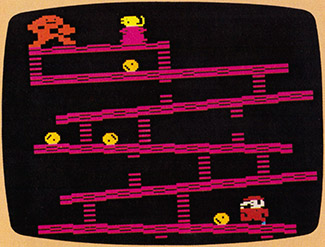
If there were Academy Awards for video games, ColecoVision’s Kong would walk away with Oscars for Best Picture and Screenplay (no pun intended). This is no Pac-Man. Coleco, in translating Nintendo’s coin-op hit to the home medium, has managed to capture almost every subtle nuance of play for their own home game system.
Coleco’s attention to detail is what makes this game. Mario, Mr. Kong and each of the game’s playfield configurations were carefully emulated, not bastardized. Mario even looks like a squatty little carpenter with a mustache, overalls and Casey Jones hat. Gamers who have come to accept the simple, nondescript graphics of home videogames are sure to find ColecoVision’s Donkey Kong a sophisticated departure from the norm.
Hardened arcade goers, who have all but written off home games as “too easy,” will be surprised at the challenge this game presents. On the flip side, those of you who have never set foot into a coin-op game room will get a good taste of what arcade action is like.
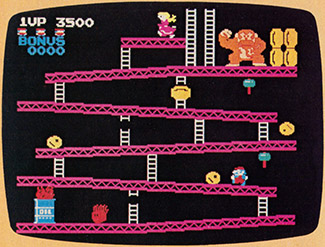
For the ever-growing ranks of Atari owners, Coleco offers Donkey Kong #2451, a laudable effort considering the limitations of the almost antique VCS. Though not nearly as sophisticated as the ColecoVision #2451 is one of the best attempts by anyone so far at the coin-op to home translation. The conveyer belt and elevator screen were excluded in the VCS version, but the total effect is enhanced by detailed graphics which are, by VCS standards, above average. Here again, Mario is depicted as a somewhat chubby fellow, hat and mustache included.
The game begins, as all three versions do, with a ramp screen. Once this structure is scaled, Mario finds himself at the bottom of the rivet sequence. here is where Coleco changed a few things around. In this version, each of the four floors are equal in length. The tenacious fireballs are confined to one level and patrol their respective story by moving back and forth at a constant speed. Once all the rivets have been removed, Mario returns to face Kong again on the ramp screen.
By the way, I take great pleasure in reporting that the infamously agile garden variety Atari joystick performs well in every situation you may encounter in Donkey Kong. My only gripe. with the game is that the conflict between Mario and Mr. Kong is never really resolved. The foolhardy carpenter’s climb is treacherous, but at no point in the game does he ever actually save the fair maiden. Then again, the fun lies not in the triumph, but the struggle.
Programming Quirks
Donkey Kong #2471, the Intellivision compatible rendition, is a welcome change of pace for Intellivision owners. This is one of the few cartridges in the system’s library that doesn’t require the player to constantly refer to the instruction booklet and punch in an esoteric code on the keypad. The game flows, somewhat. The hindrance here is the directional disk. It takes a little practice to find up, down, left and right, but most Intellivision veterans have probably already deciphered the action of the controller. The delay between the time the jump button is pushed and when Mario reacts on the screen can be very irritating.
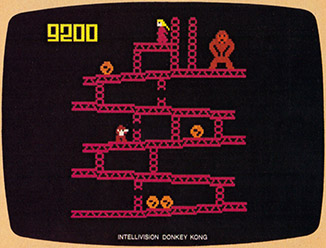
As far as graphics are concerned, they struck me as a bit disappointing by Intellivision standards. The overall tone of the game characters is a putrid green. Hence, Mr. Kong looks more like Swamp Thing with gangrene than an ape.
Even though #2471 is not the best-looking Intellivision compatible game available, it is one of the few licensed arcade games in the system’s library. Most of the other cartridges available in the Intellivision format are reworkings or generic versions of popular titles.
After playing the ColecoVision for a few weeks, and Donkey Kong especially, it appears that this system will be a wealth of secret messages and those little programming quirks we have come to know and love. For instance, in the first screen of Donkey Kong, I have found I could climb up the girders, leap off the right side and bounce off a wall instead of falling off the building! I have also seen barrels rolling upward and Mario “beam up” ladders without having to climb them.
While a lot of people may think of these quirks as mistakes or flaws in the program, I think most video game fans look upon these idiosyncrasies with a sense of humor. It’s fun to discover these clues and wonder if they were accidents or were intentionally placed in the program for sharp video gamers to discover. It seems that in the 1980s, instead of looking for clues that Paul is dead on the covers of Beatles’ albums, we are examining our video game cartridges very closely to see what they really say.
Don’t waste time bashing barrels. Every second you are losing 100 bonus points. Take the shortest route to the top of the screen.
Michael Blanchet is the author of How To Beat The Video Games.
Activision/Atari VCS
Video games aficionados can be divided into two very distinct camps—action game freaks and adventure game freaks. But Piifall!, Activision’s new one, is an adventure game that may intrigue people who hate adventure games.
Your mission is to make your way through a jungle collecting treasures while you avoid obstacles such as crocodiles, scorpions. cobras, swamps. quicksand and tar pits. The outstanding feature of Pitfall! is the game’s complexity. Instead of just 10 or 20 “rooms” to explore, Piifall! has 255 jungle scenes. In addition, there is an underground passageway that can shorter your trip by allowing you to move at a faster pace.
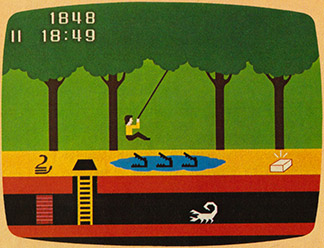
Piifall! requires a great deal of eye-hand coordination. It is necessary to jump over rolling logs and other obstacles, the same way you do in Donkey Kong. However, even if you are an expert hurdler, there still is the problem of limited time. You have to complete the entire course in 20 minutes, and if you think that’s plenty of time, just wait.
The problem with a lot of adventure games is that once you know the course, all the “adventure” is gone. But in Pitfall!, not only must you race against time, but you must also attempt to score a maximum number of points (You begin with 2,000 and lose or gain points as you play). So even after you know the route through the jungle, you can still beat your own previous score.
There is one scene that is especially difficult. You are faced with a pond filled with three crocodiles. There is no rope to swing from. You have to cross the pond to continue and the only way to do that is to walk over the crocodiles. The first 10 or 20 times you try. you’ll probably fall into the drink. However, there is a trick to help you (see tip below).
Pitfall! is an extremely colorful game with graphics so good you’ll really feel like you’re in the jungle. The burning fires, slithering cobras and swinging vines are incredibly detailed. And effects like the wild Tarzan yell when you swing your vine across the snapping crocodiles makes this the best game from Activision yet.
Don’t try to jump over all the crocodiles at once. Jump on the first head. Wait. Jump on the second head. Wait. Jump on the third head. Wait. Jump off.
U.S. Games/Atari VCS
The true test of a game is whether you come back to it. Space Jockey is a game that, if you like this certain type of game, you’ll come back again and again.
Similar to Defender and Chopper Command, you are an “Attack Saucer” with vertical mobility that must fight various enemies that stream at you from the right side of the screen. Points are awarded for shooting tanks, jets, prop planes and helicopters. Of course, they’re gunning for you too and their trigger fingers are very quick.
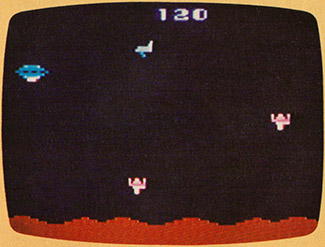
There is nothing meaty here. This is a simple theme stripped to the bare essentials. But that doesn’t mean it’s bad. Space Invaders was the simple kill-or-be-killed variety of game also. The graphics here don’t knock you out. The sound is nothing to phone home about. Space Jockey is a pure test of your reaction time and doesn’t pretend to be anything more.
Space Jockey has two features that might interest you. First. if you wiggle the joystick, the screen will flash the score of the highest game since the machine was turned on. Second, if the phone rings in the middle of your battle, you can park your attack saucer between the lanes of the oncoming enemies and sit there in complete safety until you are ready to violate the ceasefire.
If you’re the type of person who says, “Hey, watch me knock that milk bottle off the fence,” you’ll probably want to become a Space Jock. If you like exploring secret rooms and video caves in search of hidden keys and things, you will probably look at Space Jockey as mindless, electronic cotton candy drivel. But cotton candy tastes so good!
Don’t wait around to see the result of your shot. By that time, you’ll probably be hit. Shoot and move before looking back.
Dan Gutman is Managing Editor of Electronic Fun with Computers and Games.
Spectravision/Atari VCS
Ever since Tempest hit the streets, we have been told that it’s too complicated to be turned into a home game. But games come and go in popularity and now that it’s getting harder and harder to find the game in the arcades, Spectravision has taken the Tempest theme and translated it into a home game that will knock your socks off.
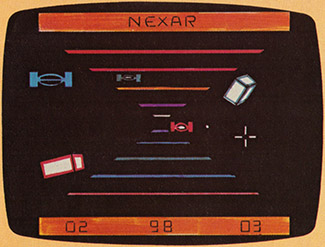
There’s a lot of talk about 3-D games lately. But as long as a TV screen is a flat two-dimensional object. true 3-D is impossible. The best we can achieve is the illusion of 3-D. This can be accomplished with glasses (as in 3-D movies) or shadows (as in Zaxxon and Activision’s Tennis). Bu t you can get a very powerful 3-D illusion simply by having objects start as a pinprick on the screen and make them get larger. This is what Atari did with Tempest (on a vector screen), and Spectravision has now done the same with Nexar. In Nexar, you are in a space warp (a black field really, with horizontal lines to indicate perspective). Radioactive Beacons and Impact Exploding Saucers originate as dots in the center of the screen and come at you, getting bigger the “closer” they get. You may avoid them or shoot them. Unlike Tempest, you are not restricted to the outer rim of a platform. You may wander freely all over the screen and let aliens zip light by if you like. However, also unlike Tempest, there is a time limit. Unless you destroy the squadron in 90 seconds, the game is over regardless of how many lives you have left.
Nexar will keep you busy for awhile. There are 99 levels and the highest possible score is 999,995. Spectravision warns “Do not attempt Nexar if you have high blood pressure.” If things get too hairy, you can freeze the action indefinitely by flipping the color/black & white switch. But frankly, this game is so fast. by the time you take your hand off the joystick to flip the switch, you’re a dead man. This game will definitely make you sweat.
Play with your feet. Rest one toe on your color switch and flip it if you are about to get hit. As the action is frozen, survey the field and act accordingly.
Imagic/Atari VCS
Not since Hitchcock’s The Birds has anything inspired such a fear of winged creatures as Demon Attack. In this vibrantly colorful, highly imaginative and challenging game, Imagic has replaced the standard relentlessly descending aliens with wave after wave of rainbow-colored birds who, by a strange quirk of evolution, have developed lasers as part of their anatomical makeup.
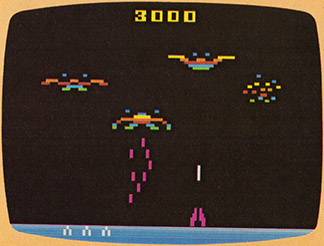
The birds are assembled light before your eyes, too. Instead of having square-looking invaders marching in orderly rows, half of each winged attacker flashes across the screen from an opposite end, fusing in the middle, where it wastes no time before it starts to drop bombs. They swoop and swerve and you have to be quick and a little clairvoyant to anticipate where to shoot first.
Different game variations (there are eight) give you different shooting capabilities. For example, variation one allows you one shot at a time, while the succeeding ones allow for rapid fire. This is much better. You can just keep on shooting and one of your shots will hit something sometime. But remember, you’ve also got to avoid being hit by their fire.
As the game progresses, it becomes increasingly difficult. Where one bird was easily destroyed by a single shot in the easier variations, it now takes two shots because each one you hit, like the Hydra, becomes two. And these two are much smaller and much quicker and therefore much harder to hit. (Rats. Just when you thought you were getting good, too.)
The game is challenging yet not discouraging. Although it is tough to destroy the birds, it’s not so tough that you don’t get any of them. You do manage to get through enough waves to feel rather self-satisfied and it is this that is one of the most appealing aspects of the game. It invites you, by tantalizing you with a taste of victory, to continue…then it destroys you.
Imagic/Intellivision
High atop the Empire State Building, Fay Wray is being held captive by King Kong (or a gorilla that looks remarkably like him). No, this is not another movie remake. This is a video game remake. Fay Wray seems to have lost most of her golden hair and appears to be solid gray, but let us not forget that she’s been in this simian’s clutches for close to fifty years now. Taking that into account. she looks damn good. Your incarnation in this game is that of a little man and you must scale the walls of the skyscraper to rescue Fay (or. if you prefer, think of her as Jessica Lange). This is not as easy as it sounds. If, in fact. it sounds easy at all. You have to align yourself with an open window and then jump up to the ledge above it. The windows have minds of their own. They open and close in an annoyingly random way, and if a window is closed, you cannot use it to go up. Once you’ve attained the ledge, you then make another mad dash for the next open window and continue upwards. There are four ledges in the first screen.
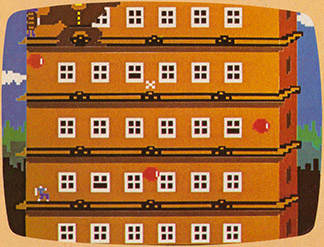
While you’re running around looking for open windows, you’ve got to watch out for hazards such as falling rocks, flying birds and little kitties that will trip you and knock you back to the ground floor.
If you do manage to get to the ledge where King Kong (or his facsimile) is standing, the screen flashes to a picture of a city skyline and a little biplane flies overhead trailing a banner which reads either “Well done,” “Good job,” or “Lucky,” among other messages. Then you find yourself back on the side of the building, several floors higher than you were before.
In order to levitate to the next ledge, it is necessary to push the buttons on the controller at the same time that you depress the top of the disc. This keeps the little guy afloat longer and higher, enabling you to float effortlessly up. A word of warning: While evading birds and other creatures, don’t get too enthusiastic about running away. You can run right off the edge and fall several stories to a grisly end.
One thing I am happy to report is that, although Beauty & the Beast is an Intellivision game, it doesn’t require that you memorize different numbers on the keypad for different functions. All you use are the disc and fire buttons. This makes it even more enjoyable. This does not. in any way. mean that the game is not challenging or complex. It is. It takes 20/20 peripheral vision to anticipate and avoid the rocks and other flak, as well as a sharp eye and quick trigger finger to time your leaps precisely. The running, dodging and evasive action, as well as the burning curiosity to know just what awaits you on the next level. definitely maintain the interest level. This is no game for acrophobes.
Climbing up the side of a building is no picnic. In order to do this most efficiently, you must hold down the two firing buttons and press the top of the disc simultaneously.
Randi Hacker is Senior Editor of Electronic Fun and author of Video Review’s Last Word on Home Video Games.
Data Age/Atari VCS
“Winning,” Vince Lombardi once intoned, “isn’t everything. It’s the only thing.” Vince Lombardi obviously never lived to play video games. The best anybody can do is hold out as long as possible until the end.
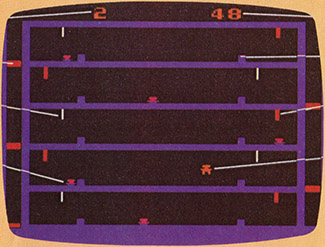
What distinguishes Airlock, then, isn’t its graphics, its play value or its degree of challenge—all of which are pretty undistinguished—but the fact that it’s one of the first video games ever that you can win. Not just turn the counter over, or walk away from when the timer runs out, but win. Vince would’ve liked that.
The fact you can beat Airlock isn’t enough to save you from a fate similar to that which befalls the onscreen protagonist—drowning. He at least has the short-lived satisfaction of knowing he’s going down with his ship or, in this case, submarine. You only get to drown in boredom. Airlock is one more variation on the Donkey Kong theme, with your protagonist leaping over vaguely described “barriers” and rolling torpedoes knocked loose “by an eerie current from deep under the sea floor.” He must retrieve, in order. two airlock keys for each of the submarine levels to which he must ascend via elevator. He has 49 or 99 “seconds” to reach the top level and escape. with water flooding successive levels every 10 “seconds.” (In real time, 10 game-seconds takes about 20 seconds in the easy mode and 15 in the difficult.) You can choose five or 10-level, as well as one- and two-player variations (which doesn’t make much sense to me, since you only get one man per game and could just share a single joystick).
At first, the game is challenging because, in the difficult mode at least. you can’t slip up even once. Trip over a barrier, get bowled over by a torpedo, or even take more than one leap to get a key, and when those first 10 seconds are up, you’re sunk. But once you’ve got that first level down, each progressive level becomes easier because you accumulate unused seconds.
There’s little to this game once you’ve passed the first level. The torpedoes are easy enough to avoid, and the grand trick of timing your man to leap over both barrier and torpedo at once doesn’t take much practice. And granted, video games ought to be as free from the close scrutiny of logic as movie musicals, but this game doesn’t even have internal consistency.
Why, for example, do the torpedoes pass ghostlike through the barriers while your hero can’t? Why does each level fill up with water in the blink of an eye, scuttling your hero even if he’s made it to an elevator and is no more than a fish’s whisker from the next level? Sinking vessels may take on water quickly, but not that quickly, and having the man slosh through rising water may have made the game more interesting. Even the central conceit—that you can win by escaping—loses its gloss when you see your character jumping for joy atop a soon-to-be-ex-submarine, with no rescue ships in sight.
I have to give Data Age credit for fleshing out one of my video game fantasies—beating the machine—but with Airlock, even when you win, you lose.
SPACE ATTACK 


 / SUPER CHALLENGE BASEBALL
/ SUPER CHALLENGE BASEBALL 

Mattel/Atari VCS
One of the pioneering M Network space games is Space Attack, which is a translation of the Intellivision game Space Battle. Here the Atari joystick does prove superior to the infamous disc.
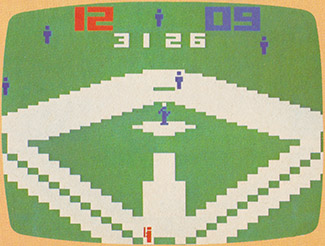
Space Attack starts out in a confusing green screen known as the radar mode. You must select an alien fleet that will be the object of your attack and then dispatch one of your squadrons to do so. If you fiddle with the joystick and red fire button long enough, you will end up in the battle mode, where you train your gunsight on alien ships and proceed to fire your lasers. Destroy the alien fleet and you go back to radar mode, dispatch another squadron and so on. When in battle mode, you must avoid the aliens’ red photon blasts.
The battle mode is entertaining but not that challenging. The lack of overlay makes the radar mode a chore. Until you memorize the different maneuvers necessary for choosing the aliens you want to go after and the squadrons with which you want to attack, you will find yourself glancing at the instructions often. putting you at an disadvantage.
Although Intellivision’s space games have never measured up to Atari’s, their sports cartridges have set the standard for the industry. One of the first armchair athlete competitions produced by M Network was Super Challenge Baseball.
Super Challenge Baseball is a worthwhile investment for the VCS owner. It is not quite the equal of Intellivision’s Major League Baseball, but is more than adequate for any video sports addict. Graphics remain realistic despite the absence of a shortstop. Sending the center fielder after the ball did prove difficult.
Mattel has more M Network cartridges for Atari use rolling out of the factories. Titles include Armor Ambush, International Soccer, Frogs ‘n’ Flies, Dark Cavern, Lock ‘n’ Chase, Sea Battle, Super Challenge Football and Tron Deadly Discs.
Some of the joystick functions overlap so commit the joystick movements and what they control to memory as soon as possible. This will improve your precision.
Suzan Prince is the author of How To Win At Home Video Games.
US Games/Atari VCS
Everything, it seems, is eventually updated. First there were silents, then talkies. First there was TV. now there are video games. And Word Zapper is the electronic update of the traditional spelling bee.
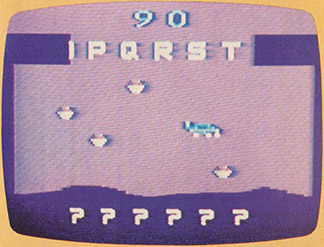
The object of this war of the words is to read a word generated by the computer and then, using your Zapper spaceship, shoot out the letters in their proper order as they whiz by at the top of the screen. This is a race against time and attackers-attackers, I might add, who want nothing more than to see you fail spelling.
There are four different enemy types: Doomsday Asteroids which destroy you when they hit you; Scroller Asteroids which scramble the order of the alphabet and Bonker and Zonker Asteroids which simply shift the position of your ship and ruin your aim.
Pressing the fire button without touching the joystick directs the laser beam upward towards the letters and beams them down to the bottom of the screen. Moving the joystick allows you to shoot right or left at the various predators.
You get three words of up to six characters and, as time runs out, it gets tougher and tougher to capture the letters you need in time.
A delightful game of alphabet swoop.
If the letter you need is at the end of the alphabet, let one of the Scroller Asteroids hit you.
Telesys/Atari VCS
Anyone who’s spent time denying themselves all the rich, greasy, delicious stuff of which fast food and dieters’ dreams are made, rejoice. There’s a new game that allows you to eat up as many calories as you want without having to worry about thunderthighs. Appropriately named Fast Food, it doesn’t cause zits, obesity or tooth decay.
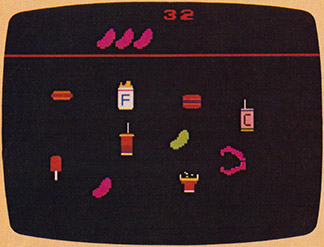
You are Mr. Mouth. You speed up and down. back and forth across the black screen as you try to gobble down all the unhealthy, American staple foods that zip in from the left side of the screen. As the difficulty increases, so does the speed at which the food flies. From Fast Food to Faster Food until they become SSTs (SuperSonic Tidbits).
There are milkshakes, cans of soda, french fries, hamburgers, ice cream cones and more. And the graphics are remarkably detailed. The ice cream sodas have a fizzy, frothy head and sesame seeds can almost be seen flying off the buns as the hamburgers gun by you. Mr. Mouth himself is a fantastic replica of those little chattering teeth my uncle used to sell in his store.
Points are calories and the more calories the item you catch in Mr. Mouth is worth, the higher you score.
Among the flying vittles (sounds like a team of trapeze artists) are pickles. But, as any gourmand will tell you, there are pickles and there are pickles and not all pickles are as innocent as they look. There are the garden variety green pickles which go well with hamburgers and then there are the nefarious purple pickles which give you indigestion. This makes sense. Purple is not a good color for pickles.
At all costs, avoid purple pickles. If you eat six of them, you’re out. The screen goes blank and the word “Burp” appears. This is embarrassing and considered gauche (except in India where it’s considered polite).
Although the graphics are, as I said, really excellent and very, very colorful and it is a great deal of fun to race Mr. Mouth back and forth across the screen and watch him turn around, the game itself is oddly unsatisfying. You get full after a couple of rounds but, unlike Chinese food, one hour later, you’re not really hungry to play again.
Stay to the extreme right of the screen no matter how hungry you get. Advancing on the food doesn’t leave you enough time to tell the purple pickles from the green.
Odyssey/Odyssey²
Weep no more K.C. Munchkin lovers, K.C. is back with a vengeance in K.C.’s Krazy Chase—and the folks at Atari may just have done the folks at Odyssey a big favor. The original K.C. Munchkin was yanked off store shelves after Atari got the courts to agree that it looked—and played—a little too much like you-know-who (Pac-Man, if you don’t). K.C.’s Krazy Chase is more complex, faster and more interesting than its predecessor and K.C.’s new nemesis—the dreaded Dratapillar and her Drats—are far more menacing than the original Munchkin monsters. If the Drats don’t get you, the Dratapillar will.
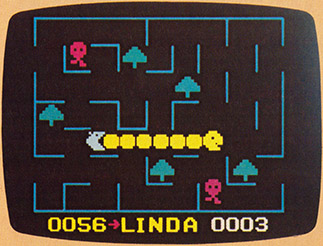
In this new game, the object is to nibble up all the little Dratapillar segments before the darting Drats or the devious Dratapillar’s head get you. Once you’ve gobbled up all those segments, the game enters a new phase, with a new Dratapillar and two new Drats moving at a faster, more furious pace. The Drats aren’t always dangerous, however. Every time K.C. digests a Dratapillar segment, the Drats go white with fright and become legitimate targets for Mr. Munchkin.
But beware. When the blood starts pumping and they regain full color, the Drats once again become iethal K.C. stalkers—one inadvertent brush with a Drat and it’s curtains for K.C. As with the original K.C. Munchkin, the new game offers a variety of different mazes, but Krazy Chase also offers players the option of programming their own mazes. presenting a nearly infinite number of maze configurations.
Scoring is relatively simple: three points for each Dratapillar segment eaten; 20 points for all segments; 10 points for nibbling up a Drat and one point for ingesting one of the numerous trees that dot the hazardous landscape.
KC’s Krazy Chase is one of Odyssey’s new voice-enhanced cartridges, although it can be played without The Voice. With The Voice, KC acquires an extensive vocabulary and is able to say things like “Remarkable!”
Stay right on the Dratapillar’s toil. Resist the temptation to go off in search of frightened Drats. When you do that, the wily Dratapillar senses your vulnerability and doubles back to bite your blind side.
Art Levis, a well-known figure in the electronics field, is editor of Consumer Electronics Monthly.
CommaVid/Atari VCS
Are all video game programmers frustrated exterminators? Judging from the recent rash of bug-oriented games, it appears to be so. To further confirm the belief comes Cosmic Swarm, a better-than-could-be-expected Centipede clone that carries a fair challenge but falls short in the graphics and control departments.
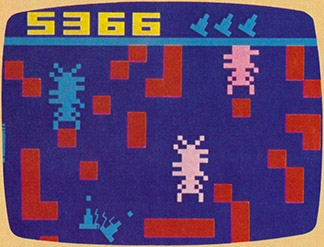
The preliminary (and mostly unnecessary) scenario attempts to get you into the vermin destroying mood by placing you on the “immense” (but never seen) Waypoint Interstellar Trade Depot. Aboard the vast ship lies a dormant colony of giant alien mineral-eating termites. The nasties have invaded the main power-conversion chamber (they must not have been dormant after all). It’s up to you to put down the alien menace by guiding a tiny Asteroids-style probe ship and blasting the cosmic crawlers out of existence.
As in the usual game regime, you get three ships, but there’s a hitch. After every 30 seconds, you must refuel your craft by docking with another ship. Despite the ease of blasting the bugs, even experts won’t score millions. Hitting a blockless termite or one without a nest is worth a mere one point. Hitting a termite with a block is worth just two points.
The graphics are about as simplistic as the scoring. Everything, including the ships and the termites, is square-shaped and solid colored. The blocks that represent nests are just that—blocks. After a while, the screen looks as if you’re playing bug checkers. The controls are no more of a bargain. When the fire button is up, pushing the joystick will move your ship horizontally, vertically and diagonally. When the fire button is down, pushing the joystick will move the probe ship vertically, rotate the direction of the ship or do both at the same time.
The uninspiring graphics and complex controls utlimately make Cosmic Swarm alluring only to those who want to “play ‘em all” or think spraying a Raid can is just about as much fun as humans should be allowed to have.
Be alert to the buzzer sound that heralds the refueling ship. Begin to move towards that side as soon as the vehicle begins its descent.
Mart Trost is a New York-based freelance writer and consultant specializing in video and cable TV.
Mattel/Intellivision
Disregard the misleading title of this game. Stripped of its cops-chasing-a-bandit theme, Lock ‘N’ Chase is Mattel’s version of Atari’s mega-hit Pac-Man—and they’ve created what appears to be a sure winner.
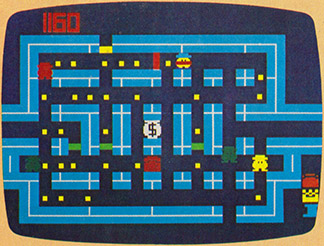
In Lock ‘N’ Chase, a quick-witted thief is loose in a maze-like bank vault. Scattered throughout the vault are dozens of gold coins (not unlike the dots in Pac-Man). The thief glides through the alleys and corridors picking up the loot and racking up points. Four somewhat slower policemen chase the bandit. After five bandits are caught, the game is over.
Fortunately, Lock ‘N’ Chase has some distinctive features that make it much more than just another shameless Pac-Man clone. Several times in the course of a game, a cash bag appears in the center of the vault. The thief must sneak into the heart of the vault to pilfer the dough and score extra points. Also, at other moments, gold crowns and other valuable treasures suddenly materialize. If the thief makes off with any of them, the score soars as well.
One of the major assets of Lock ‘N’ Chase is the ability of the player to lock doorways behind the thief with a flick of a button on the keypad. If too many policemen are stalking the thief, he can make a door slam in back of him and literally obstruct justice. Learning just when to close the doors is a sophisticated piece of video gamesmanship, but it’s a shrewd design ploy that adds points and excitement.
Lock ‘N’ Chase has some other nice touches. The graphic quality is superb. Sparkling blue walls line the dark, narrow corridors. Crisply colored gold coins, remarkable in their clarity, dot every inch of the vault. In short, the game has visual splendor.
The only flaw in Lock ‘N’ Chase is directing the thief as he zig-zags through the maze. The disc at the heel of the keypad controls the direction of the thief. Many times, however, the flat disc seems incapable of properly managing vertical and horizontal movements. A joystick would undoubtedly handle the task more effectively and with far less stress on your thumb. The tendency is to press harder to make your thief run faster. This, of course, doesn’t work. The result. sadly, is a radish-colored thumb that feels like it got caught in a vault door.
But that’s a small price to pay for the enjoyment of Lock ‘N’ Chase. Once you’re playing the game you tend to forget about the pain in your hand and concentrate on grabbing the gold.
Howard Polskin writes for Time Inc’s new publication TV Cable as well as for TV Guide and other magazines.
Atari/Atari 400/800
Star Raiders takes full advantage of the superb graphics capabilities of the Atari computer to create a game so realistic and challenging that it could very well become a standard against which other combat games will be measured. The game plot is simple: In the cockpit of your space fighter, you hop from sector to sector in the galaxy destroying alien ships which threaten the Star Fleet’s base stations. Star Raiders has been widely copied by makers of standard video game cartridges—Atari now has a version for the VCS console—but none has come close to the original.
Play demands constant use of four different view screens, each acting independently. There are four skill levels, ranging from relatively easy to virtually impossible to master and, at game’s end, you are awarded one of 55 possible performance ratings from “Galactic Cook” to “Star Commander Class I.” although it’s doubtful you will see the latter flash on the screen with any frequency.
At the lower practice levels, the defense shields provide complete protection from alien fire, but at higher skill levels things get more difficult. Your objective, of course, is to shoot down the enemy ships. but it isn’t easy. The aliens know how to take care of themselves. They attack in swoops from all angles. Their torpedoes can knock out your photons and leave you unarmed, blow away your shields, blast out your engines and navigational aids and tum your ship into so much space debris.
Using your joystick for flight control and the computer keyboard for screen and speed selection, you check the galactic chart for enemy locations. Then engage hyperwarp, activate front viewer, turn on navigational-targeting computer display and put up your shields. A flashing red alarm tells you when you have entered an invaded sector. The alien ships may attack instantly, or hang back. Your status board shows their distance and direction. or you can pinpoint their locations by switching to your radar-like sector scan.
The alien fighters attack from both front and rear, often at the same time. Your photon torpedoes fire in either direction, and the selection between forward and aft view screens can be manual or left up to your onboard targeting computer. But be warned—a wrong choice can be fatal. When fighting aliens on aft view the movements of the joystick make objects behave oppositely—as they would in real life. At the top skill levels the game moves at a frantic pace, and split-second decisions and reactions are needed just for survival. Video game fans who find that some games get too easy after a while will have no such complaint with Star Raiders.
When fighting aliens on aft view, turn the control around so that the firing button is at the bottom. This makes it easier to bring the enemy into your gunsight.
Phil Gerson is 17 years old and a 10-year veteran of the video game wars. Last year he graduated to computers.
Source Pages












